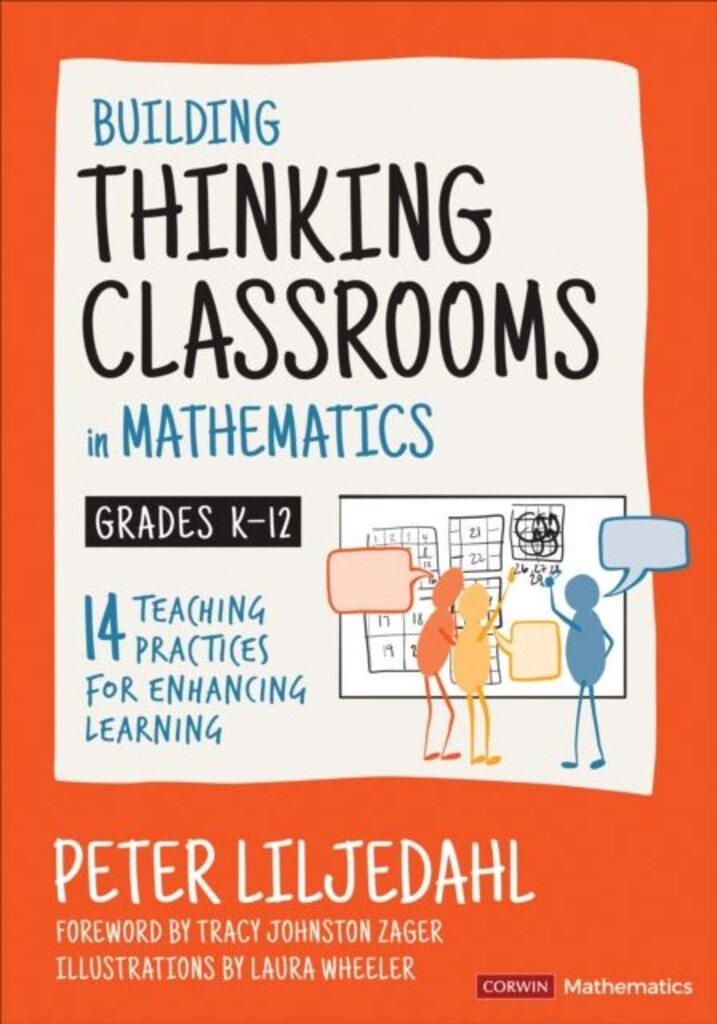Building thinking classrooms in mathematics, grades K-12 : 14 teaching practices for enhancing learning
Peter Liljedahl · foreword by Tracy Johnston Zager ; illustrations by Laura Wheeler
Bok Engelsk 2021
| Originaltittel | |
|---|---|
| Medvirkende | Wheeler, Laura (illustratør)
|
| Utgitt | Corwin , 2021
|
| Omfang | xxii, 315 sider : illustrasjoner
|
| Opplysninger | Chapter 1: What Are the Types of Tasks We Use in a Thinking Classroom? ; Chapter 2: How We Form Collaborative Groups in a Thinking Classroom ; Chapter 3: Where Students Work in a Thinking Classroom ; Chapter 4: How We Arrange the Furniture in a Thinking Classroom ;Chapter 5: How We Answer Questions in a Thinking Classroom : Chapter 6: When, Where, and How Tasks are Given in a Thinking Classroom ; Chapter 7: What Homework Looks Like in a Thinking Classroom ; Chapter 8: How We Foster Student Autonomy in a Thinking Classroom ; Chapter 9: How We Use Hints and Extensions in a Thinking Classroom ; Chapter 10: How we Consolidate a Lesson in a Thinking Classroom ; Chapter 11: How Students Take Notes in a Thinking Classroom ; Chapter 12: What We Choose to Evaluate in a Thinking Classroom ; Chapter 13: How We Use Formative Assessment in a Thinking Classroom ; Chapter 14: How We Grade in a Thinking Classroom ; Chapter 15: Pulling the 14 Practices Together to Build a Thinking Classroom. - Teachers often find it difficult to implement lessons that help students go beyond rote memorization and repetitive calculations. In fact, institutional norms and habits that permeate all classrooms can actually be enabling “non-thinking” student behavior. Sparked by observing teachers struggle to implement rich mathematics tasks to engage students in deep thinking, Peter Liljedahl has translated his 15 years of research into this practical guide on how to move toward a thinking classroom. Building Thinking Classrooms in Mathematics, Grades K–12 helps teachers implement 14 optimal practices for thinking that create an ideal setting for deep mathematics learning to occur. This guide: Provides the what, why, and how of each practice and answers teachers’ most frequently asked questionsIncludes firsthand accounts of how these practices foster thinking through teacher and student interviews and student work samples. Offers a plethora of macro moves, micro moves, and rich tasks to get started. Organizes the 14 practices into four toolkits that can be implemented in order and built on throughout the yearWhen combined, these unique research-based practices create the optimal conditions for learner-centered, student-owned deep mathematical thinking and learning, and have the power to transform mathematics classrooms like never before.. - info:sid/primo.exlibrisgroup.com-BIBSYS_ILS
|
| Emner | |
| Dewey | |
| ISBN | 978-1-5443-7483-3
|
Building Thinking Classrooms in Mathematics, Grades K-12 : 14 Teaching Practices for Enhancing Learning
Peter Liljedahl
Bok · Engelsk · 0
Peter Liljedahl
Bok · Engelsk · 0
Building thinking classrooms in mathematics, grades K-12 : 14 teaching practices for enhancing learning
Peter 1967- Liljedahl
Bok · Engelsk · 2021
Peter 1967- Liljedahl
Bok · Engelsk · 2021
